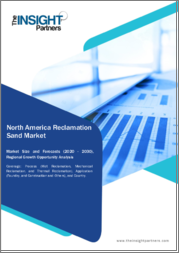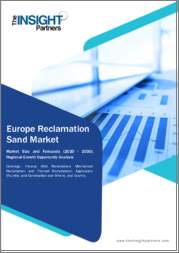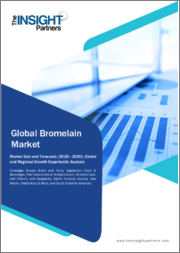
|
시장보고서
상품코드
1438040
세계의 재생 모래 시장 : 공급원별, 입도별, 프로세스별, 용별, 지역별 세계의 분석 및 예측(-2030년)Reclamation Sand Market Forecasts to 2030 - Global Analysis By Source, Grain Size, Process, Application and By Geography |
||||||
Stratistics MRC에 따르면, 세계의 재생 모래 시장은 2023년에 17억 8, 000만 달러를 차지하였고, 예측 기간 동안 복합 연간 성장률(CAGR) 8.1%로 성장할 전망이며 2030년에는 27억 9, 000만 달러에 이를 것으로 예측됩니다.
재생 모래는 토지 확장 및 개발 프로젝트에 필수적인 하천, 해안 및 호수에서 공급되는 경우가 많은 퇴적물을 의미합니다. 모래 재생에는 모래를 물리적, 화학적, 열적으로 처리하여 주형 및 중자 만들기에 재사용하는 것이 포함됩니다. 모래 재생 공정에서는 주물 제조 시 모래 입자에 부착된 바인더와 코팅제를 제거하고 모래를 재사용합니다.
캐나다 정부 기관인 캐나다 통계국에 따르면 2021년 주택건설에 대한 모래투자액은 28.4% 증가한 1, 620억 달러였지만 비주택건설 투자율은 0.9% 감소했습니다.
인프라 개발 프로젝트 증가
재생 모래는 토지의 확장과 강화를 촉진함으로써 인프라 개발 프로젝트에서 중요한 역할을 합니다. 해안 지역의 매립과 조성에 사용되어 항만, 공항, 도시의 워터 프론트 개발 등의 프로젝트에 새로운 토지를 창출합니다. 각국이 인프라 정비를 선호하는 가운데 재생 모래 수요는 계속 급증하고 있습니다. 이 동향은 시장이 인프라 프로젝트에 의존하고 있다는 것을 부각하고 있으며, 당분간은 지속적인 확대가 예상됩니다.
환경에 대한 배려
재생 모래의 환경 문제로는 서식지 파괴, 퇴적, 해양 생태계 파괴 등이 있습니다. 채굴은 해양 생물과 생물 다양성에 해를 끼치며 어업에 영향을 줄 수 있습니다. 또한 부적절한 모래 채굴 방법은 침식을 일으켜 해안 안정성에 영향을 줄 수 있습니다. 이러한 환경문제에 대한 규제의 강화나 사회의식의 고조가 과제가 되고 있어 시장 확대의 방해가 되고 있습니다.
해안보호에 대한 의식 증가
해안보호에 대한 의식이 높아지면 침식과 해수면 상승으로부터 해안선을 지키는 것의 중요성을 지역사회에 인식하고 있습니다. 재활용 모래는 해안 방어를 강화하고 완충지대를 만들고 지속가능한 개발을 위해 땅을 매립하는데 매우 중요한 역할을 합니다. 정부와 단체는 해안보호를 우선하는 프로젝트에 대한 투자를 늘리고 있으며, 재생모래 수요를 밀어 올리고 있습니다. 이러한 의식 증가는 환경 문제에 대한 우려와 일치하고, 재생 모래 시장에서 책임있는 지속 가능한 관행으로 긍정적인 전환을 촉진하고 시장 성장을 더욱 강화하고 있습니다.
토지이용분쟁
재생 모래의 토지 분쟁은 채굴 사업이 기존 토지 이용을 침해하고 지역사회, 농민, 원주민 그룹과의 분쟁으로 이어질 때 발생합니다. 토지를 둘러싼 이해의 갈등은 항의 활동, 법적 과제, 프로젝트 지연으로 이어질 수 있습니다. 이러한 분쟁은 원활한 조업을 방해할 뿐만 아니라 업계의 평판을 떨어뜨려 규제 강화로 이어질 가능성도 있습니다. 따라서 이러한 측면은 시장 수요를 저해하고 있습니다.
COVID-19의 영향
COVID-19의 유행은 재생 모래 시장에 큰 영향을 미쳤습니다. 잠금, 공급망 혼란, 건설 활동 감소가 수요 감소로 이어졌습니다. 여행 제한은 국제 무역을 방해하고 모래 수출에 영향을 미쳤습니다. 그러나 인프라 정비를 중심으로 한 건설 프로젝트가 점차 재개되고 시장은 회복력을 보이고 있습니다. 과제에도 불구하고, 지속가능한 개발에 대한 세계의 관심은 시장의 향후 동향에 영향을 미치고, 수리 및 토지 매립 프로젝트에서 재생 모래 수요 증가로 이어질 수 있습니다.
예측 기간 동안 습식 매립 분야가 최대화될 전망
습식 재생 부문은 유리한 성장을 이루는 것으로 추정됩니다. 모래 재생에서 습식 재생은 사용한 주물 모래를 재생하기 위해 물을 사용합니다. 이 방법은 귀중한 주물 모래를 회수하고 재사용하고 폐기물을 줄이고 환경에 미치는 영향을 최소화하는 데 도움이 됩니다. 재생 모래의 품질을 향상시키고 주조 공정에서 재사용 적성을 높이는 효과적인 솔루션입니다. 자원의 효율화를 촉진하고 모래 폐기와 관련된 환경 풋 프린트를 줄임으로써 지속 가능한 주조 실천에 기여하는 것이이 부문의 성장을 뒷받침하고 있습니다.
예측기간 동안 폐수처리 프로젝트 분야의 복합 연간 성장률(CAGR) 가장 높아질 전망
폐수 처리 프로젝트 분야는 예측 기간 동안 가장 높은 복합 연간 성장률(CAGR) 성장이 예상됩니다. 재생 모래는 폐수 처리 프로젝트에서 매우 귀중합니다. 입경이 미세하기 때문에 여과 효율이 높아져 수중 불순물이나 침전물의 제거가 용이해집니다. 이 모래의 높은 투수성은 처리 시스템의 효과적인 배수와 물 흐름을 지원합니다. 여과성, 배수성 및 미생물 활성을 향상시키는 범용성은 폐수 처리 프로젝트의 성공과 지속가능성에 기여하여 깨끗한 물 생산을 보장합니다.
최대 점유율을 차지하는 지역
아시아태평양은 간척 프로젝트 수요 증가로 예측 기간 동안 최대 시장 점유율을 차지할 것으로 예측됩니다. 인프라 개발, 도시화, 해안보호 이니셔티브의 급증으로 고품질 모래 수요를 촉진하고 있습니다. 싱가포르, 말레이시아, 인도네시아와 같은 국가들은 준설 활동이 중요한 역할을 하고 있으며 시장에 크게 기여하고 있습니다. 이 지역이 계속 시장 개발을 우선하고 있기 때문에 재생 모래 시장의 번영이 예상되어 건설, 준설 업계공급자나 이해 관계자에게 기회를 가져오고 있습니다.
복합 연간 성장률(CAGR) 가장 높은 지역:
중동 및 아프리카는 견고한 인프라 정비와 연안 보호 노력을 통해 예측 기간 동안 가장 높은 복합 연간 성장률(CAGR)을 나타낼 것으로 예측됩니다. 급속한 도시화와 해양 활동이 확대됨에 따라 인공섬, 항만, 워터프론트 개발 등 프로젝트를 위한 재생 모래에 대한 수요가 증가하고 있습니다. UAE, 사우디아라비아, 이집트 등 이 지역의 국가들은 도시 확장과 관광을 위한 매립 활동에 많은 투자를 하고 있습니다. 또한 책임있는 채굴 관행과 환경 기준 준수에 대한 관심이 높아짐에 따라이 지역 시장은 크게 성장하고 있습니다.
무료 맞춤형 서비스
이 보고서를 구독하는 고객은 다음 무료 맞춤설정 옵션 중 하나를 사용할 수 있습니다.
- 기업 프로파일
- 추가 시장 기업의 종합적 프로파일링(3개사까지)
- 주요 기업의 SWOT 분석(3개사까지)
- 지역 세분화
- 고객의 관심에 응한 주요국 시장 추계, 예측, 복합 연간 성장률(CAGR)(주: 타당성 확인에 따름)
- 경쟁 벤치마킹
- 제품 포트폴리오, 지리적 존재, 전략적 제휴에 기반한 주요 기업 벤치마킹
목차
제1장 주요 요약
제2장 서문
- 개요
- 이해관계자
- 조사 범위
- 조사 방법
- 데이터 마이닝
- 데이터 분석
- 데이터 검증
- 조사 접근
- 조사 소스
- 1차 조사 소스
- 2차 조사 소스
- 전제조건
제3장 시장 동향 분석
- 성장 촉진요인
- 억제요인
- 기회
- 위협
- 용도 분석
- 신흥 시장
- COVID-19의 영향
제4장 Porter's Five Forces 분석
- 공급기업의 협상력
- 구매자의 협상력
- 대체품의 위협
- 신규 참가업체의 위협
- 경쟁 기업간 경쟁 관계
제5장 세계의 재생 모래 시장 : 공급원별
- 강 모래
- 해사
- 호수의 모래
- 사막의 모래
- 기타 정보원
제6장 세계의 재생 모래 시장 : 입도별
- 미세 모래
- 보통 모래
- 거친 모래
- 맞춤형 블렌드
- 기타 입도
제7장 세계의 재생 모래 시장 : 프로세스별
- 기계적 재생
- 습식 재생
- 열재생
- 기타 프로세스
제8장 세계의 재생 모래 시장 : 용도별
- 치수 프로젝트
- 파이프라인 건설
- 저수지와 댐의 건설
- 폐수 처리 프로젝트
- 콘크리트 제조
- 비치의 영양 보급
- 농지의 확대
- 기타 용도
제9장 세계의 재생 모래 시장 : 지역별
- 북미
- 미국
- 캐나다
- 멕시코
- 유럽
- 독일
- 영국
- 이탈리아
- 프랑스
- 스페인
- 기타 유럽
- 아시아태평양
- 일본
- 중국
- 인도
- 호주
- 뉴질랜드
- 한국
- 기타 아시아태평양
- 남미
- 아르헨티나
- 브라질
- 칠레
- 기타 남미
- 중동 및 아프리카
- 사우디아라비아
- 아랍에미리트(UAE)
- 카타르
- 남아프리카
- 기타 중동 및 아프리카
제10장 주요 발전
- 계약, 파트너십, 협업, 합작 투자
- 인수와 합병
- 신제품 발매
- 사업 확대
- 기타 주요 전략
제11장 기업 프로파일
- Iluka Resources Limited
- Tochu Corporation
- Asahi Yukizai Corporation
- MAT Foundry Group
- Resand Oy
- Pioneer Construction Materials Limited
- Mangalore Minerals Limited
- Finecast Foundry Limited
- JFE Mineral & Alloy Co Limited
- Mitsubishi
- Saint-Gobain
- Select Sands
- Pattison Sand Company LLC
- Nugent Sand Inc
According to Stratistics MRC, the Global Reclamation Sand Market is accounted for $1.78 billion in 2023 and is expected to reach $2.79 billion by 2030 growing at a CAGR of 8.1% during the forecast period. Reclamation sand refers to sedimentary material, often sourced from rivers, coasts, or lakes, crucial for land expansion and development projects. Sand reclamation involves physical, chemical, or thermal treatment of sand for reuse in molding and core making. During the sand reclamation process, binders & coatings that adhere to sand grains during casting production are removed to recycle sand for subsequent use.
According to Statistics Canada, an agency of the Government of Canada, in 2021, the sand investment in residential construction was up by 28.4% to US$162.0 billion as compared to non-residential construction, having a fall in investment by 0.9%.
Market Dynamics:
Driver:
Rising infrastructure development projects
Reclamation sand plays a vital role in infrastructure development projects by facilitating land expansion and enhancement. It is used to reclaim and build upon coastal areas, creating new land for projects like ports, airports, and urban waterfront developments. As nations prioritize infrastructure upgrades, the demand for reclamation sand continues to surge. This trend underscores the market's dependence on infrastructure projects, positioning it for continued expansion in the foreseeable future.
Restraint:
Environmental concerns
Environmental concerns in reclamation sand include habitat destruction, sedimentation, and disruption of marine ecosystems. Extraction can harm marine life and biodiversity, impacting fisheries. Additionally, improper sand mining practices can lead to erosion, affecting coastal stability. The market faces challenges due to increased regulatory scrutiny and public awareness regarding these environmental issues, thereby hampering the market expansion.
Opportunity:
Growing awareness of coastal protection
Growing awareness of coastal protection makes communities recognize the importance of safeguarding coastlines against erosion and rising sea levels. Reclamation sand plays a pivotal role in bolstering coastal defences, creating buffer zones, and reclaiming land for sustainable development. Governments and organizations are increasingly investing in projects that prioritize coastal protection, boosting the demand for reclamation sand. This heightened awareness aligns with environmental concerns, driving a positive shift towards responsible and sustainable practices in the reclamation sand market, further supporting its growth.
Threat:
Land use conflicts
Land conflicts in Reclamation Sand arise when extraction operations encroach on existing land use, leading to disputes with local communities, farmers, or indigenous groups. Competing interests for land can result in protests, legal challenges, and project delays. These conflicts not only hinder smooth operations but also damage the industry's reputation and may also lead to stricter regulations. Therefore, this aspect hinders the market demand.
Covid-19 Impact
The covid-19 pandemic significantly affected the reclamation sand market. Lockdowns, supply chain disruptions, and reduced construction activities led to a decline in demand. Travel restrictions hindered international trade, impacting sand exports. However, the market has shown resilience with the gradual resumption of construction projects, particularly in infrastructure development, driving a recovery. Despite challenges, the ongoing global focus on sustainable development influenced the market's future dynamics, potentially leading to increased demand for reclamation sand in restoration and land reclamation projects.
The wet reclamation segment is expected to be the largest during the forecast period
The wet reclamation segment is estimated to have a lucrative growth. Wet reclamation in sand reclamation involves the use of water to reclaim used foundry sand. This method helps recover and recycle valuable foundry sand, reducing waste and minimizing environmental impact. It is an effective solution for improving the quality of reclaimed sand, enhancing its suitability for reuse in foundry processes. Its contribution to sustainable foundry practices by promoting resource efficiency and reducing the environmental footprint associated with sand disposal is fuelling the segment growth.
The wastewater treatment projects segment is expected to have the highest CAGR during the forecast period
The wastewater treatment projects segment is anticipated to witness the highest CAGR growth during the forecast period. Reclamation sand proves invaluable in wastewater treatment projects. Its fine particle size enhances filtration efficiency, facilitating the removal of impurities and sediments from water. The sand's high permeability supports effective drainage and water flow in treatment systems. Its versatility in improving filtration, drainage, and microbial activity contributes to the success and sustainability of wastewater treatment projects, ensuring cleaner water output.
Region with largest share:
Asia Pacific is projected to hold the largest market share during the forecast period owing to the increasing demand for land reclamation projects. The surge in infrastructure development, urbanization, and coastal protection initiatives are driving the demand for high-quality sand. Countries like Singapore, Malaysia, and Indonesia are significant contributors to the market, with dredging activities playing a crucial role. As the region continues to prioritize development, the reclamation sand market is expected to thrive, presenting opportunities for suppliers and stakeholders in the construction and dredging industries.
Region with highest CAGR:
Middle East & Africa is projected to have the highest CAGR over the forecast period, owing to the robust infrastructure development and coastal protection initiatives. With rapid urbanization and expansion of maritime activities, there's a heightened demand for reclamation sand for projects like artificial islands, ports, and waterfront developments. Countries in the region, such as the UAE, Saudi Arabia, and Egypt, are investing heavily in reclamation activities for urban expansion and tourism. Further, with increasing attention on responsible extraction practices and adherence to environmental standards, the region's market is boosting profoundly.
Key players in the market
Some of the key players profiled in the Reclamation Sand Market include Iluka Resources Limited, Tochu Corporation, Asahi Yukizai Corporation, MAT Foundry Group, Resand Oy, Pioneer Construction Materials Limited, Mangalore Minerals Limited, Finecast Foundry Limited, JFE Mineral & Alloy Co Limited, Mitsubishi, Saint-Gobain, Select Sands, Pattison Sand Company LLC and Nugent Sand Inc.
Key Developments:
In August 2023, Finland-based Resand has developed an innovative new technology that enables the cleaning and recycling of foundry sand. Through continuous product development, Resand has now made a breakthrough that also enables the regeneration of ceramic sand.
In January 2022, MAT Foundry started using sand reclamation at their EURAC Poole facility. Instead of taking degraded sand to landfill, it is now cleansed by a specialist machine - known as a 'secondary attrition unit'. By scrubbing the sand clean, it becomes suitable for new processes and experiences a far longer lifecycle - which is expected to reduce consumption of new sand by 5,000 tonnes per annum.
Sources Covered:
- River Sand
- Sea Sand
- Lake Sand
- Desert Sand
- Other Sources
Grain Sizes Covered:
- Fine Sand
- Medium Sand
- Coarse Sand
- Customized Blends
- Other Grain Sizes
Processes Covered:
- Mechanical Reclamation
- Wet Reclamation
- Thermal Reclamation
- Other Processes
Applications Covered:
- Flood Control Projects
- Pipeline Construction
- Reservoir & Dam Construction
- Wastewater Treatment Projects
- Concrete Production
- Beach Nourishment
- Agricultural Land Expansion
- Other Applications
Regions Covered:
- North America
- US
- Canada
- Mexico
- Europe
- Germany
- UK
- Italy
- France
- Spain
- Rest of Europe
- Asia Pacific
- Japan
- China
- India
- Australia
- New Zealand
- South Korea
- Rest of Asia Pacific
- South America
- Argentina
- Brazil
- Chile
- Rest of South America
- Middle East & Africa
- Saudi Arabia
- UAE
- Qatar
- South Africa
- Rest of Middle East & Africa
What our report offers:
- Market share assessments for the regional and country-level segments
- Strategic recommendations for the new entrants
- Covers Market data for the years 2021, 2022, 2023, 2026, and 2030
- Market Trends (Drivers, Constraints, Opportunities, Threats, Challenges, Investment Opportunities, and recommendations)
- Strategic recommendations in key business segments based on the market estimations
- Competitive landscaping mapping the key common trends
- Company profiling with detailed strategies, financials, and recent developments
- Supply chain trends mapping the latest technological advancements
Free Customization Offerings:
All the customers of this report will be entitled to receive one of the following free customization options:
- Company Profiling
- Comprehensive profiling of additional market players (up to 3)
- SWOT Analysis of key players (up to 3)
- Regional Segmentation
- Market estimations, Forecasts and CAGR of any prominent country as per the client's interest (Note: Depends on feasibility check)
- Competitive Benchmarking
- Benchmarking of key players based on product portfolio, geographical presence, and strategic alliances
Table of Contents
1 Executive Summary
2 Preface
- 2.1 Abstract
- 2.2 Stake Holders
- 2.3 Research Scope
- 2.4 Research Methodology
- 2.4.1 Data Mining
- 2.4.2 Data Analysis
- 2.4.3 Data Validation
- 2.4.4 Research Approach
- 2.5 Research Sources
- 2.5.1 Primary Research Sources
- 2.5.2 Secondary Research Sources
- 2.5.3 Assumptions
3 Market Trend Analysis
- 3.1 Introduction
- 3.2 Drivers
- 3.3 Restraints
- 3.4 Opportunities
- 3.5 Threats
- 3.6 Application Analysis
- 3.7 Emerging Markets
- 3.8 Impact of Covid-19
4 Porters Five Force Analysis
- 4.1 Bargaining power of suppliers
- 4.2 Bargaining power of buyers
- 4.3 Threat of substitutes
- 4.4 Threat of new entrants
- 4.5 Competitive rivalry
5 Global Reclamation Sand Market, By Source
- 5.1 Introduction
- 5.2 River Sand
- 5.3 Sea Sand
- 5.4 Lake Sand
- 5.5 Desert Sand
- 5.6 Other Sources
6 Global Reclamation Sand Market, By Grain Size
- 6.1 Introduction
- 6.2 Fine Sand
- 6.3 Medium Sand
- 6.4 Coarse Sand
- 6.5 Customized Blends
- 6.6 Other Grain Sizes
7 Global Reclamation Sand Market, By Process
- 7.1 Introduction
- 7.2 Mechanical Reclamation
- 7.3 Wet Reclamation
- 7.4 Thermal Reclamation
- 7.5 Other Processes
8 Global Reclamation Sand Market, By Application
- 8.1 Introduction
- 8.2 Flood Control Projects
- 8.3 Pipeline Construction
- 8.4 Reservoir & Dam Construction
- 8.5 Wastewater Treatment Projects
- 8.6 Concrete Production
- 8.7 Beach Nourishment
- 8.8 Agricultural Land Expansion
- 8.9 Other Applications
9 Global Reclamation Sand Market, By Geography
- 9.1 Introduction
- 9.2 North America
- 9.2.1 US
- 9.2.2 Canada
- 9.2.3 Mexico
- 9.3 Europe
- 9.3.1 Germany
- 9.3.2 UK
- 9.3.3 Italy
- 9.3.4 France
- 9.3.5 Spain
- 9.3.6 Rest of Europe
- 9.4 Asia Pacific
- 9.4.1 Japan
- 9.4.2 China
- 9.4.3 India
- 9.4.4 Australia
- 9.4.5 New Zealand
- 9.4.6 South Korea
- 9.4.7 Rest of Asia Pacific
- 9.5 South America
- 9.5.1 Argentina
- 9.5.2 Brazil
- 9.5.3 Chile
- 9.5.4 Rest of South America
- 9.6 Middle East & Africa
- 9.6.1 Saudi Arabia
- 9.6.2 UAE
- 9.6.3 Qatar
- 9.6.4 South Africa
- 9.6.5 Rest of Middle East & Africa
10 Key Developments
- 10.1 Agreements, Partnerships, Collaborations and Joint Ventures
- 10.2 Acquisitions & Mergers
- 10.3 New Product Launch
- 10.4 Expansions
- 10.5 Other Key Strategies
11 Company Profiling
- 11.1 Iluka Resources Limited
- 11.2 Tochu Corporation
- 11.3 Asahi Yukizai Corporation
- 11.4 MAT Foundry Group
- 11.5 Resand Oy
- 11.6 Pioneer Construction Materials Limited
- 11.7 Mangalore Minerals Limited
- 11.8 Finecast Foundry Limited
- 11.9 JFE Mineral & Alloy Co Limited
- 11.10 Mitsubishi
- 11.11 Saint-Gobain
- 11.12 Select Sands
- 11.13 Pattison Sand Company LLC
- 11.14 Nugent Sand Inc















